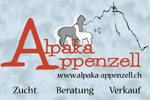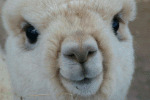Articles by Alpaca World Magazine:
Choosing a Stud Male
Rachel Hebditch
Selecting a stud male is one of the most important factors affecting the progress of your breeding programme. As the Australian judge Dianne Condon, who owns the Shanbrooke Alpaca Stud, says; “males have a huge influence on a large number of females over the period of their breeding life; so if they don’t come up to standard, don’t use them.”
Not all breeders will be looking for the same thing in their stud males. American breeder and author Mike Safley has this to say about selection; “The art of the selection process is subjective. What do you, as a breeder, want your herdsire to reflect in his offspring? A certain colour, maybe heavy bone or a particular head shape. Do you want large or small alpacas? Fibre quality is extremely important, but can also be subjective. How does it feel or ‘handle’? Is fineness more important than volume?”
You may be breeding for the show ring, for commercial fleece production, for particularly attractive animals that will be sold as ‘pets’ or to produce the very best animals in the UK of a particular colour such as black or fawn.
So the first decision the breeder has to make is to decide what their breeding objectives are and secondly to look at their females realistically and try to work out what quality of stud male would set them on the road to meeting those objectives. It is worth bearing in mind that we are talking animal breeding here and that alpacas, unlike fruit flies, do not do anything in a hurry. You may well not achieve your objectives in one generation, it is far more sensible to take the long view. This will involve ‘breeding up’ and probably using a succession of males to eventually reach your goal. It will take time but there is the satisfaction of knowing that you did it ‘your way’.
The only way to assess a stud male’s genotype is to test the progeny. Mike Safley explains on his Northwest Alpacas website; “The genetically correct way to select alpacas with high breeding value is by progeny testing. This involves using a selection index to evaluate a stud's offspring for important traits, such as fleece weight and density. This means not just evaluating the stud's outstanding cria; either all of the offspring, or a random sample large enough to ensure accuracy, must be measured. To be accurate, progeny testing must be done in an environmentally neutral manner. This means that all the cria examined must have been raised in similar circumstances with similar feed and care.
By way of example, alpaca shows have a Progeny class where three offspring are shown together, hopefully representing the male's production capacity. As a breeder looking to purchase a replacement male, would you rather base your buying decision on the three offspring that the exhibitor brought to the show or a complete survey of the cria from the stud's production? Believe me, the large sample is superior. The second approach to progeny testing, which is more complex, is to use the dam's statistics to create an index that measures how much a sire improves the cria over the dam. Analysing just the male's progeny is easier, and testing all the offspring, or a representative random sample, of a particular male creates a high degree of selection accuracy for breeding values.”
Many breeders will not have enough cria on the ground to do such large scale testing, but if there are any cria available, it will be helpful to look at them and their dams.
Much stud selection has been made on the basis of phenotype – that is what the animal looks like. If the animal has a pedigree that contains successful males and females in terms of fleece quality, comformation etc., then the stud is more likely to be prepotent for these traits. If there is no pedigree then the judgement has to be made on the animal itself.
Comformation is important. The international judge Allan Jinks of the Benleigh Alpaca Stud in Australia says;
“The alpaca should be in proportion and compact, with a broad chest and hindquarters. Upstanding animals with ‘presence’ and good strong bone structure are desirable. When walking, the hind legs should follow the front legs and the back legs should not touch, that is be cow-hocked. The front legs can be slightly deviated from the knees. The animal should look alert, with upright bayonet shaped ears. (Banana shaped ears are typical of the llama) Ears must not be fused at the tips. Teeth must not be over or undershot – they must meet the upper dental pad.
Testicular size should be inspected. Both should be large and of even size. It is undesirable for the alpaca to have blue eyes, as some have been found to have hearing problems. Temperament would not be classed as a high criteria, as most alpacas are easy to manage.”
Dianne Condon again; “A true stud sire should look like a Macho with strong bone and excellent conformation, he should have presence and be well proportioned moving evenly through the show ring. His fleece must be of the highest standard, after all this is what we are breeding them for. The qualities I like to see in a fleece is first of all fineness and softness, this is what it is all about, however it is no use having this if he only has a handful of fleece on his body, so he must have density. I look for a blusterous slippery fleece, this usually indicates a low CV and a lack of medullation. Coverage on the head, legs and belly are also an indication of a dense animal and these finishing points are what give the animal presence in the show ring. Finally I like to see a high frequency deep amplitude crimp carried evenly over the entire body through into the legs, belly and chest.”
If correct comformation is a given in any animal being used as a stud male, then the quality of the fleece will be the decisive factor. Anyone who uses alpaca fibre is looking for fineness, a good handle, density and brightness. There is plenty of discussion going on in the industry about crimp and bundling and whether it is always a marker for fineness and density. Crimp and bundling do well in the show ring and are usually indicators of fineness and density. However there are fine, dense fleeces which exhibit crinkle as opposed to a very defined crimp. The weight of the fleece at shearing will tell you whether an animal is dense and grows a long staple quickly and the histogram will give you a pretty good idea of its fineness.
Another crucial factor is how quickly the alpaca’s fleece coarsens as it gets older. Ideally the stud male’s owner will have taken fleece samples at every shearing which will tell you whether the animal has held a fine fleece for a good number of years.
There are a number of other factors that will influence your decisions on stud males. One is price – use the best stud male you can afford – but make sure the price is within the budget you have set for the year. Look at ways of reducing the cost. Most farms offer discounts over a certain number of females. If you have to transport females, can you share the cost with another breeder. If you clubbed together could you get a better deal on more matings.
Drive by matings, when you take the female to the male, are usually the cheapest, followed by mobiles, when the males come to you. You may be able to lease a male for the season so that he stands on your farm or buy a share in a male. Another factor is distance. If you don’t want your females to stay on a stud farm until they are 60 days, you will need to choose your males from breeders that are reasonably close.
And how do you choose a stud farm? Look for a breeder who you are confident knows what they are doing, that you get on with, is happy to answer your questions, keeps good records, looks after their animals well and offers an excellent range of services.
The Canadian breeder and judge Maggie Krieger makes an important point; “Selection of stud quality males is key to any successful breeding programme for not only should the male be the most correct available but the breeder must have the knowledge and expertise to know and anticipate what the quality of the offspring will be. This is expertise that can only be developed through experience. The ultimate test of the good breeder is one that can produce a stud quality male through their own breeding programme. After all anyone can go out and buy a stud male.”
This goal of breeding one’s own stud males is one we all aspire to but is only just starting to be realised in Britain. However just a tiny proportion of young males will be good enough to be stud males. As Mike Safley points out; How does the breeder select and develop herdsires and cria free of fault? At Northwest Alpacas we are unforgiving about even the smallest flaw. My Dad always said "don't fall in love with your male until it is full grown." Babies change, small flaws grow into major faults. If you've already decided that a particular baby male is your one and only, you may be blinded to his faults by the time he is of breeding age. Remember, the herdsire will be a father to all of your cria. Any given dam will only contribute a fraction of the genes to your crop of offspring.”
The last word from Allan Jinks; “ The purchase or use of a male is an important investment. Take time to check if he has progeny on the ground. Consider if he is consistently producing similar cria. Ask for fleece test data. See the dams and decide if he is making the improvements you require. Be prepared to DO YOUR HOMEWORK!
Tweet



